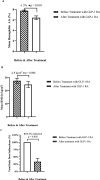GLP-1 RA and dual GIP/GLP-1 RA treatment in MODY: a descriptive case series
- PMID: 40274278
- PMCID: PMC12020758
- DOI: 10.1136/bmjdrc-2024-004885
GLP-1 RA and dual GIP/GLP-1 RA treatment in MODY: a descriptive case series
Abstract
Introduction: Glucagon-like peptide-1 receptor agonists (GLP-1 RA) and dual glucose insulinotropic polypeptide (GIP)/GLP-1 RA are widely prescribed, but their effectiveness in different subtypes of maturity-onset diabetes of the young (MODY) is unknown.
Research design and methods: We present a descriptive case series of individuals from two MODY cohorts who used GLP-1 RA or dual GIP/GLP-1 RA. Paired t tests were used to compare HbA1c, body mass index (BMI), and sulfonylurea (SU) dose before and after GLP-1 RA or dual GIP/GLP-1 RA therapy.
Results: 10 individuals (4 hepatocyte nuclear factor-1α (HNF1A)-MODY, 4 hepatocyte nuclear factor-4α (HNF4A)-MODY, 1 ATP-binding cassette transporter subfamily C member 8 (ABCC8)-MODY, 1 hepatocyte nuclear factor-1β (HNF1B)-MODY) were identified who used GLP-1 RA or dual GIP/GLP-1 RA. In patients with HNF1A-MODY and HNF4A-MODY, GLP-1 RA reduced HbA1c by 1.3% (p=0.010), BMI by 2.90 kg/m2 (p=0.008), and total daily dose of SU by 66.6% (p=0.005). Dual GIP/GLP-1 RA treatment led to a non-statistically significant decrease in HbA1c of 1.8% (p=0.104), a statistically significant reduction in BMI of 8.73 kg/m2 (p=0.010), and all patients discontinued SU (n=2) and one discontinued insulin. In patients with ABCC8-MODY and HNF1B-MODY, GLP-1 RA reduced HbA1c by 1.2% and 1.8%, BMI by 1.1 kg/m2 and 1.2 kg/m2, and the patients no longer required treatment with SU or insulin, respectively.
Conclusions: GLP-1 RA and dual GIP/GLP-1 RA lowered HbA1c, BMI, and SU dose in patients with MODY.
Keywords: Diabetes Mellitus, Experimental; Genetics; Glucagon-Like Peptide 1; Glycated Hemoglobin A.
© Author(s) (or their employer(s)) 2025. Re-use permitted under CC BY-NC. No commercial re-use. See rights and permissions. Published by BMJ Group.
Conflict of interest statement
Competing interests: DTB, MFdF, EAO and BEG receive grant support from the Caswell Diabetes Institute and from the National Institutes of Health (grant U54DK118612-04). EAO and MFdF are funded by the National Institutes of Health (grant R01DK125513). Duality of Interest. DTB is a research investigator for Fractyl Health Laboratories, Sanofi, the Type 1 Diabetes Exchange (T1DX-QI), and Rhythm Pharmaceuticals. MFdF is an advisory board member for PTC Pharmaceuticals and was a scientific presenter in a symposium funded by Amryt Pharmaceuticals. EAO has received grant support from Aegerion Pharmaceuticals (manufacturer of metreleptin), Akcea Therapeutics, Ionis Pharmaceuticals, Gemphire Therapeutics, Novo Nordisk, Rhythm Pharmaceuticals, Fractyl Health Laboratories and GI Dynamics. EAO has served as an advisor and/or a consultant to Aegerion Pharmaceuticals, Akcea Therapeutics, Ionis Pharmaceuticals, and Regeneron. EAO has royalty rights from the use of metreleptin in lipodystrophy. WHH is on data safety and monitoring boards for Merck Sharp & Dohme and Rivus Pharmaceuticals. No other potential conflicts of interest relevant to this article were reported.
Figures


References
-
- Kavvoura FK, Owen KR. Maturity onset diabetes of the young: clinical characteristics, diagnosis and management. Pediatr Endocrinol Rev. 2012;10:234–42. - PubMed
-
- Hoffman LS, Jialal I. Diabetes, Maturity Onset in the Young (Mody) StatPearls:StatPearls Publishing; 2019. https://www.ncbi.nlm.nih.gov/books/NBK532900/1 Available. - PubMed
MeSH terms
Substances
Supplementary concepts
Grants and funding
LinkOut - more resources
Full Text Sources
Medical
